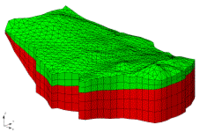GMS:Assign Node/Face BC: Difference between revisions
From XMS Wiki
Jump to navigationJump to search
No edit summary |
|||
| Line 5: | Line 5: | ||
If a set of nodes is selected when the '''''Assign Node/Face BC''''' command is selected, the ''Node BC'' dialog appears. Boundary conditions assigned to nodes correspond to Dirichlet boundary conditions. Both head and concentration can be specified. | If a set of nodes is selected when the '''''Assign Node/Face BC''''' command is selected, the ''Node BC'' dialog appears. Boundary conditions assigned to nodes correspond to Dirichlet boundary conditions. Both head and concentration can be specified. | ||
====Head==== | |||
Head boundary conditions in FEMWATER are assigned as total head. FEMWATER converts the total heads to pressure heads internally. Heads can be specified as a constant value or as a transient value (curve of head vs. time). | Head boundary conditions in FEMWATER are assigned as total head. FEMWATER converts the total heads to pressure heads internally. Heads can be specified as a constant value or as a transient value (curve of head vs. time). | ||
The '''Load Data Set''' button can be used to assign the head values from a dataset. For example, if the Elevation data set is selected, the head is set equal to the node elevation at each of the selected nodes. | The '''Load Data Set''' button can be used to assign the head values from a dataset. For example, if the Elevation data set is selected, the head is set equal to the node elevation at each of the selected nodes. | ||
====Concentration==== | |||
The concentration can also be specified as either a constant or transient value. Since the concentration is a Dirichlet boundary condition, it represents a fixed concentration at the node. It does not represent the concentration of the incoming fluid. | The concentration can also be specified as either a constant or transient value. Since the concentration is a Dirichlet boundary condition, it represents a fixed concentration at the node. It does not represent the concentration of the incoming fluid. | ||
====Face Boundary Conditions==== | |||
If a set of faces is selected when the '''''Assign Node/Face BC''''' command is selected, the ''Face BC'' dialog appears. Boundary conditions assigned to faces are flux-type boundary conditions. Both flux and concentration can be assigned independently. In both cases, the type must be designated as either Variable, Flux (Cauchy), or Flux gradient (van Neumann). The value can be defined as a constant or transient value. | If a set of faces is selected when the '''''Assign Node/Face BC''''' command is selected, the ''Face BC'' dialog appears. Boundary conditions assigned to faces are flux-type boundary conditions. Both flux and concentration can be assigned independently. In both cases, the type must be designated as either Variable, Flux (Cauchy), or Flux gradient (van Neumann). The value can be defined as a constant or transient value. | ||
